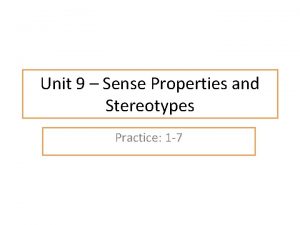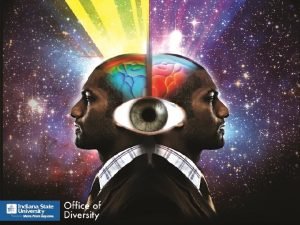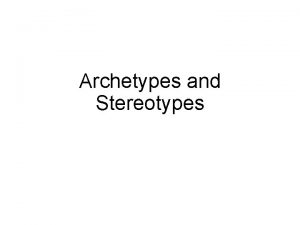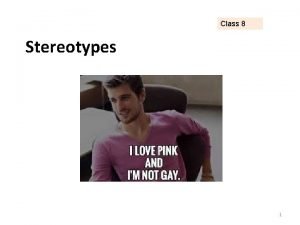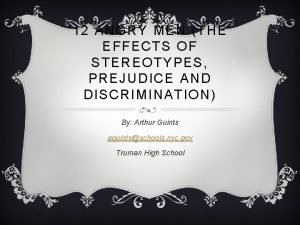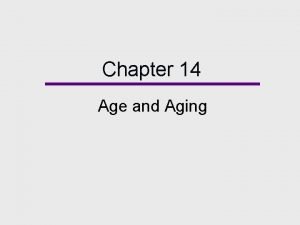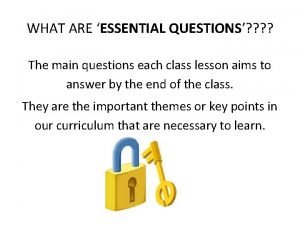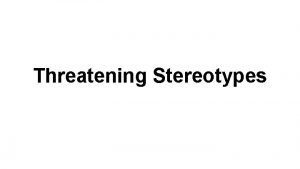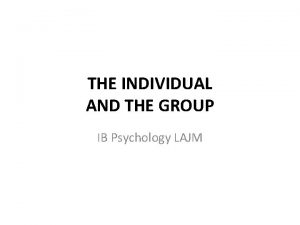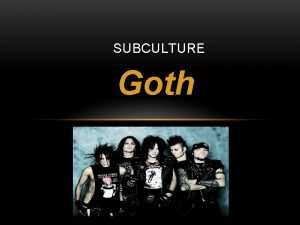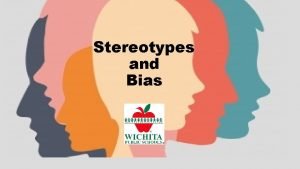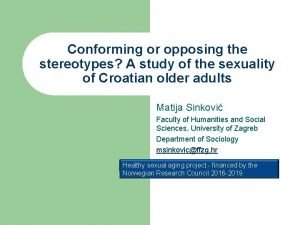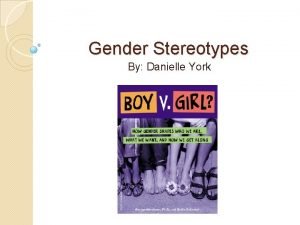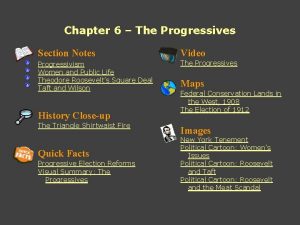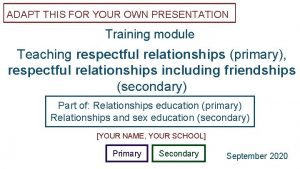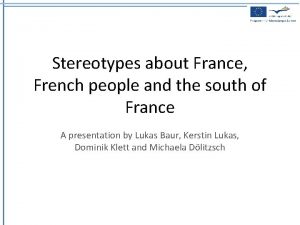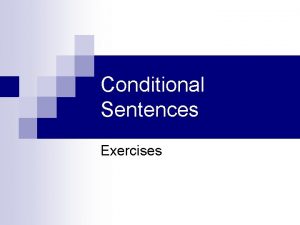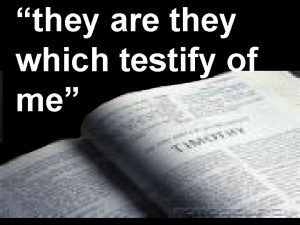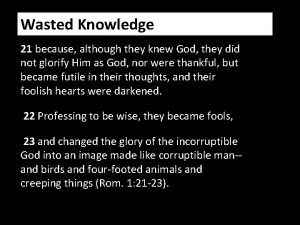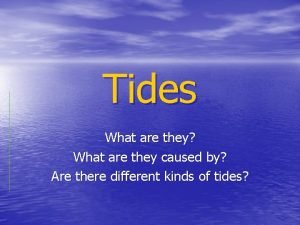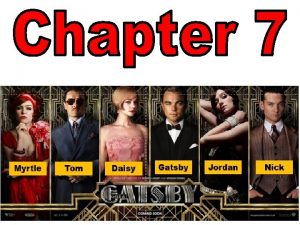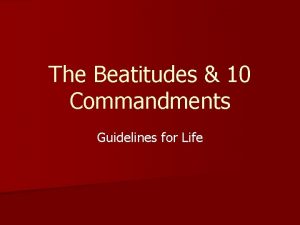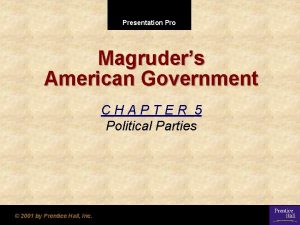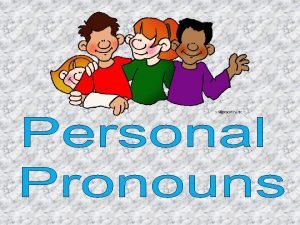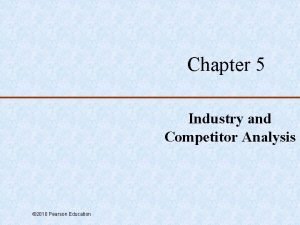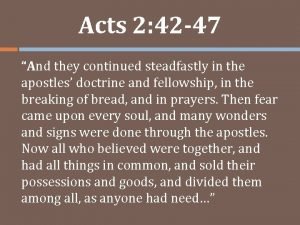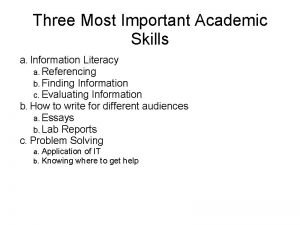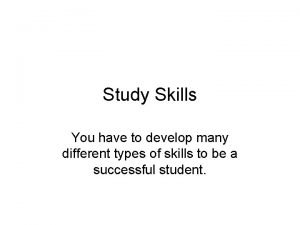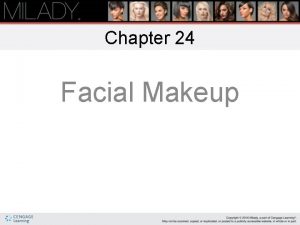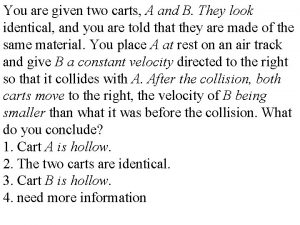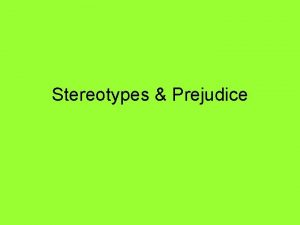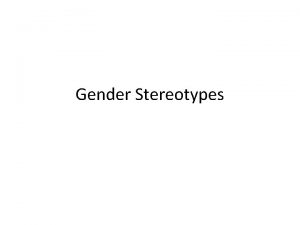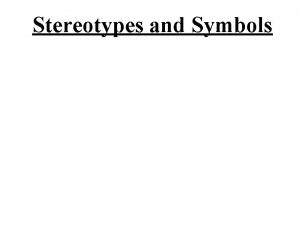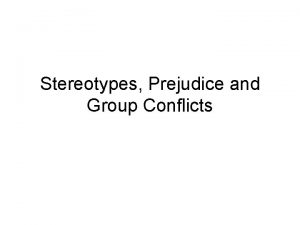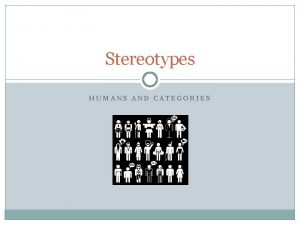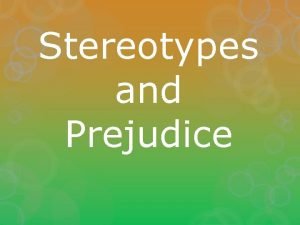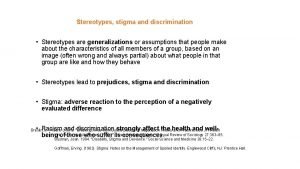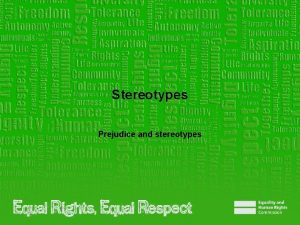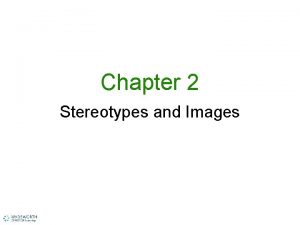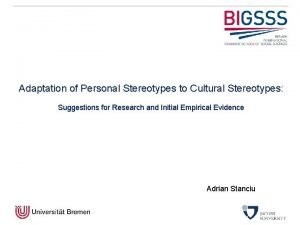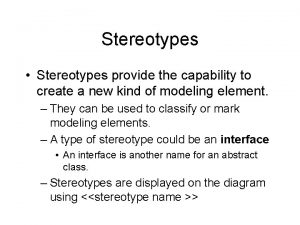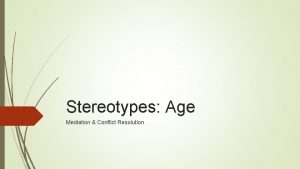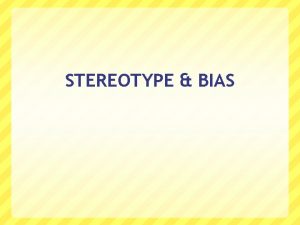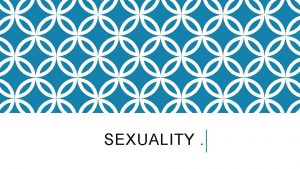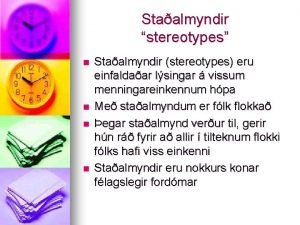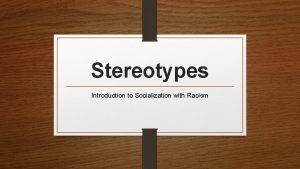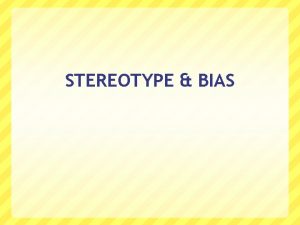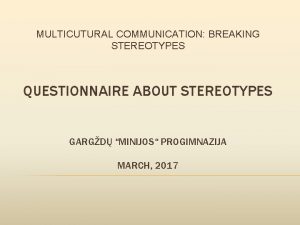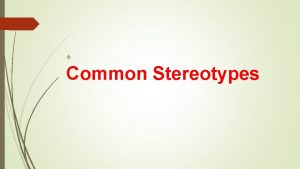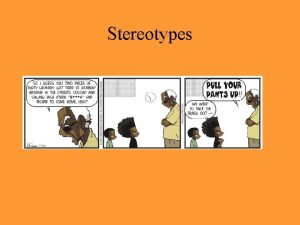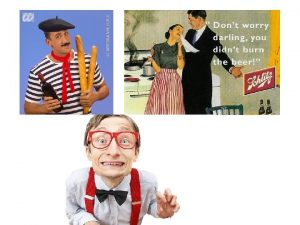Stereotypes What they are and what they do










































































- Slides: 74

Stereotypes What they are and what they do

Class Exercise: n Write a definition of “stereotype” n List some racial stereotypes of an out-group n List some racial stereotypes of your in-group n Underline (mentally, if you wish) stereotypes that you endorse

Stereotypes are often (inaccurately) stereotyped n Typical “mainstream” definitions n “a conventional, formulaic, and oversimplified conception, opinion, or image” (dictionary. com) n “a standardized mental picture that is held in common by members of a group and that represents an oversimplified opinion, prejudiced attitude, or uncritical judgment” (webster. com) n “a generalized image of a person or group, which does not acknowledge individual differences and which is often prejudicial to that person or group. ” (remember. org)

An activity from Remember. org n n n n Have students complete the following n sentences, then break up into small groups to compare their answers and n discuss if there is any prejudice and n bigotry in their answers or in those of their classmates, as well as what factors (e. g. , n n television, newspapers, friendships, attitudes of their parents) may have n contributed to such prejudice: a) All athletes are b) People on welfare all c) He's a cheap d) Drugs are used by virtually e) All homosexuals are f) All politicians are g) All people with AIDS are h) All people who sleep on grates are i) All Christian Fundamentalists are j) All male hairdressers are k) All male ballet dancers are l) All Jewish mothers are m) All Harvard graduates are n) All construction workers are o) He's so dumb, he must be p) He's so smart, he must be q) He's quick-tempered, so he must be r) He drinks like a fish, so he must be s) He likes watermelon, and so does every

Why the definitions are misleading n Stereotypes are not necessarily overgeneralizations or over-simplifications. To the contrary, they are often contextually based (Brown, 2000). n Stereotypes are not necessarily false or erroneous beliefs. They can be accurate statements about base rates (Mc. Cauley) that represent real group differences (i. e. , many stereotypes are prototypes). n Stereotypes have many useful functions

So…what are stereotypes? n Stereotypes are n Automatic and sometimes unconscious cognitive processes shared by many people and used by individuals to perceive and make sense of their environment n Shared group beliefs regarding specific traits that are attributed to people based on group membership n n n n may be accurate or false may be positive or negative may be conscious or implicit (unconscious) may be (consciously) endorsed or rejected may or may not have an impact on behavior have both positive and negative functions may have either positive or negative outcomes

Related definitions n Prejudice (affect) An attitude (usually negative) toward a distinguishable group or an individual member of that group based on group membership and without just ground (i. e. , pre-judging). n Discrimination Negative or harmful action (behavior) directed toward a distinguishable group or an individual member of that group based on group membership. Any distinction, exclusion, restriction or preference based on race, color, descent, or national or ethnic origin which has the purpose or effect of nullifying or impairing the recognition, enjoyment or exercise, on an equal footing, of human rights and fundamental freedoms in the political, economic, social, cultural or any other field of public life (UN International Convention)

Why are stereotypes shared? n n Two possible explanations 1. Stereotypes as individual beliefs (social cognition): A common environment provides similar stimulus experience to different people and therefore similar stereotypes emerge. 2. Stereotypes as collective belief systems (cultural perspective): A shared cultural pool of knowledge, social representations, ideology or culture from which different people sample and it is this which produces the commonality of views. Conclusion: Stereotypes are shared by members of groups not just through the coincidence of common experience or the existence of shared knowledge within society, but because the members of groups act to coordinate their behavior.

The benefits of stereotypes n Helps one deal with the social world more efficiently by simplifying the environment (cognitive miser hypothesis). This is useful as long as our understanding of base rates is relatively accurate. n Helps people fit in and identify with social group by underscoring the positive features of the in-group, relative to out-groups (social identity theory). n May serve a defensive function: stereotyping others may make us feel better about ourselves (self-serving bias) n In drama, allows quick introduction of characters that the audience understands and relates to (see http: //en. wikipedia. org/wiki/List_of_heroic_stock_characters)

The problem with stereotypes n Stereotypes get in the way of critical and complex thinking and can prevent us from more complex understanding n Unexamined stereotypes may not represent all, or perhaps even most individuals within a group and, therefore, lead to misunderstanding n Some stereotypes enhance our own self-identity by devaluing others and, in so doing, serve as the foundation for prejudice and discrimination n Stereotypes can be obstacles in getting to know others as they really are versus how we think they might be n Stereotypes can serve to maintain systems of privilege and injustice

Development of stereotypes: Psychodynamic approach (1940 s-1950 s) n The authoritarian personality – ethnocentrism, fascism, homophobia, and anti-Semitism part of authoritarian syndrome n Raised in a family highly structured and focused around the traditional authority of the father (usually) n Climate of repression prevents expression of hostility; in order not to explode, hostility and aggression must be projected n Due to family background, thinking is rigid, dichotomous, and stereotyped (i. e. , the “closed mind”; )

Development of stereotypes: Validity of psychodynamic approach n Original studies promising, but. . . n 1958 southern state study: n n 1952 Virginia mine study: n n n White subjects showed high levels of anti-Black prejudice, regardless of whether or not personality was authoritarian. 80% of white miners exhibited friendship and solidarity toward Black co-workers at work Out of the mines, < 20% of the white miners maintained friendly relations with Black colleagues Individual personality differences cannot explain why prejudice is almost uniform in some cultures or predict which target will be chosen and when.

Development of stereotypes: Socio-cultural approach n Social Learning Theory – stereotypes are learned through direct observation of group differences or from exposure to media and other information (remember the Bobo doll studies? ) n Illusory Correlations—tendency to see relationships between events that are unrelated (e. g. , Jane Elliot’s exercise—we will watch this in class). Happen when we are exposed to non-typical occurrences n n Imagine you read (or see) a female CEO acting aggressively. Because it is unusual to see female CEOs, the event becomes salient and memorable. As a result (because you already have such a schema), you are more likely to notice and remember future incidents of women in positions of power acting aggressively whereas contradictory info may be noticed or disregarded Result is an illusory correlation between women leaders and aggressiveness

Development of stereotypes: Socio-cultural approach (cont. ) n Kernel of Truth Hypothesis – considers whether stereotypes that people commonly hold may in fact be partially accurate n Racial stereotypes are formed in part due to group SES differences; In the U. S. , Blacks can be observed more often than whites in roles that imply less competence and less power. Due to conflation of race and class, class differences are attributed to race n Stereotypes of Jews as “cheap” and as “trying to make money” n What’s the kernel of truth? n Where does the kernel come from? n What’s the rest of the truth?

Development of stereotypes: Socio-cultural approach (cont. ) n Cognitive dissonance theory – tendency for individuals to seek consistency between behaviors and beliefs as well as among their different beliefs and opinions. n n n Information in conflict with belief system is unpleasant; something must change to relieve dissonance Information in contrast to belief is avoided, actively refuted, or seen as an “exception” Stereotypes are reinforced

Is the media responsible for racism? Is the media to blame? “The greatest peril in America today is a knavish press … pouring out the floods of falsehoods, like poisoned gas which blinds us and makes it impossible for us to see straight or to think straight. ” ~ Upton Sinclair (1918, original source)

Trust in the media n Trust in media was at 74 percent in 1976 in the post-Watergate reporting era, according to Gallup. n That number dropped to 32 percent in 2016, the last time Gallup polled on the question. Just 14 percent of Republicans said they trusted the media in that poll.

Trust in Media: The political divide q 92 percent of Republicans and Republican-leaning independents "say that traditional news outlets knowingly report false or misleading stories at least sometimes q Democrats agree by a slight majority of 53 percent

Media bias? n Structural bias “Man bites dog” standard of what is newsworthy leads to illusory correlations regardless of politics n n Black on white crime Palestinians throwing rocks at armed Israelis n Implicit bias (next slide) n Political bias n n n Setting the agenda Framing the story Representing the actors

Media (implicit? ) bias in coverage of Hurricane Katrina Read full story at Snopes. com

Setting the Agenda

Framing the Story n Foreground vs background Detailed write-up Local example: “Some of them [students] walked into Crescent Drive in front of the school. As that occurred, a vehicle travelled through the crowd. At least one of the students struck the vehicle’s window and caused damage to the glass, according to police, who were called to the scene. ” [see full article]

Detailed write-up Framing the Story (cont. ) n Distance determines what level of detail we see n People of color often see certain things differently from white Americans in regard to race, because they are much closer to the many ways that racism and racial bias operate in our society. n n Normally, those closest are presumed to see best, but not when it comes to racism. It's possible to get so close to something that it’s no longer possible to see all of it clearly.

Framing the story (cont) Detailed write-up n Our location determines our point of view This also applies to social location Respectability politics are more likely to be asserted by folks like Bill Cosby, Charles Barkley, and the handful of other Blacks who have the good fortune to either be part of the top 1% or realistically aspire to get there.

Detailed write-up Framing the story (cont) n The more ambiguous the facts, the more likely we are to project ourselves into the story n n Sometimes that’s good storytelling Other times it warps reality The “All in the Family” study According to a 2009 study: “Conservatives were more likely to report that Colbert only pretended to be joking and genuinely meant what he said while liberals were more likely to report that Colbert used satire and was not serious when offering political statements

The Role of Social Cognition:

Categorization n Categorization is the classification of persons into groups, often on basis of common attributes n n n Unintentional, effortless, automatic activity of the mind Culturally shared Assimilation vs. differentiation n Key Points n We create the categories; Categorization seems to be an essential part of the natural world, but not the categories themselves n How we categorize tends to be culturally influenced and shared and has social and political implications (see next slide) n Items grouped together tend to be viewed more alike than they are in actuality; items in different categories may have their differences exaggerated. n Once person is categorized into a group (e. g. , gender, race), we bring into play knowledge contained in the category (our schemas, our stereotypes) n Leads to ingroup/outgroup dynamics.

Cultural influences on stereotypes Large numbers of observers share similar stereotypes of a given target group and these stereotypes are relatively stable over time but also somewhat adaptive. Katz & Braly (1952/1933): Princeton students’ stereotypes of the Japanese • • • In 1933: intelligent, industrious, etc. In 1951: sly, shrewd In 1969: same as in 1933

In-group & Out-group Dynamics n In-group: group with which an individual identifies and feels a member of (ILL-INI) n Out-group: group with which an individual does not identify (“Muck Fichigan”) n In-group bias?

Class Demonstration 1. Distribute $1000 2. Rate how much you like group members 3. Rate group members’ academic performance 4. Distribute unpleasant task (e. g. , transcribing video)

Tajfel (1982) Minimal Group Experiment n Placed complete strangers in groups based on trivial criteria (e. g. , a coin toss). Results indicated: n More liking for members of own group n Rated ingroup members more positively (on personality and work performance) n Gave more money and rewards to ingroup members. Importantly: Maximizing group differences generally preferred to maximizing ingroup outcomes. n No group differences in punishing or assigning unpleasant tasks n Why?

Drawbacks to Social Categorization n Outgroup homogeneity: the perception that individuals in the outgroup are more similar to each other than they really are n Leads us to overestimate the difference between groups and underestimate the differences within groups n Reinforces stereotypes n Reinforces: “Us versus Them” mentality

The Cognitive Miser Hypothesis n Bodenhausen (1990) n 189 students: Considering only your own “feeling best” rhythm, at what time would you get up if you were entirely free to plan your day? (6 AM, 8 AM, 11 AM) n Students divided into two groups: Morning-type person or evening-type person n n Morning types: High attention early in day; Low attention later in day Evening types: Low attention early in day; High attention later in day

Cognitive Miser Hypothesis (cont. ) n Students asked to read about a campus crime in which the evidence was mixed and then rate the guilt of the suspect who was either White or Latino. Ratings occurred either early in the day or late in the day. n What would we expect based on the cognitive miser hypothesis in terms of when stereotyping would occur?

Who should stereotype more late in the day?

Who should stereotype more early in the day?

Other experimental findings relating to cognitive theory n Emotional and cognitive states associated with MORE reliance on stereotypes n n n Anger Fear Anxiety Happiness Cognitive fatigue or disengagement n Emotional and cognitive states associated with LESS reliance on stereotypes n n n Sadness Cognitive engagement Lack of cognitive fatigue Bodenhausen, G. V. (1993). Emotions, arousal, and stereotypic judgments: A heuristic model of affect and stereotyping. In Affect, cognition and stereotyping (pp. 13 -37).

Are stereotypes automatic? n Groups can prime stereotypical thoughts and thoughts can prime stereotypical groups n Automatic processing: occurs when stimulus is encountered causing the stereotype to be accessed. Happens without conscious awareness n Controlled processing: occurs with awareness; conscious choice to disregard or ignore the stereotyped information n “Hard choice” (Fiske, 1989)

2002 Institute of Medicine Report n When Latinos and African Americans were treated by physicians for a broken bone in their leg, they received pain medication significantly less often than white patients with the same injury. … Minorities are less likely to be given appropriate cardiac medications or to undergo bypass surgery, and are less likely to receive kidney dialysis or transplants. By contrast, they are more likely to receive certain lessdesirable procedures, such as lower limb amputations for diabetes and other conditions.

The Implicit Association Test n Every man has reminiscences which he would not tell to everyone but only his friends. He has other matters in his mind which he would not reveal even to his friends, but only to himself, and that in secret. But there are other things which a man is afraid to tell even to himself, and every decent man has a number of such things stored away in his mind (Dostoyevsky) Take the IAT at https: //implicit. harvard. edu/implicit/ n Demonstration video at http: //www. youtube. com/watch? v=2 RSVz 6 VEybk Alternative video: https: //www. youtube. com/watch? v=Z 72 MHd 0 y-bs

IAT over the lifespan Replicated with preferences for flowers vs. insects

IAT results

Implicit and Explicit Attitudes, by Race The IAT effect (a D score) has a possible range of -2 to +2. Break points for ‘slight’ (. 15), ‘moderate’ (. 35) and ‘strong’ (. 65) were selected conservatively according to psychological conventions for effect size. Nosek, B. A. , Banaji, M. , & Greenwald, A. G. (2002). Harvesting implicit group attitudes and beliefs from a demonstration web site. Group Dynamics: Theory, Research, and Practice, 6(1), 101.

Political ideology and the Race IAT Nosek, B. A. , Banaji, M. , & Greenwald, A. G. (2002). Harvesting implicit group attitudes and beliefs from a demonstration web site. Group Dynamics: Theory, Research, and Practice, 6(1), 101.


Stereotypes and Biased Processing n Stereotypes impacts processing of new information Biased information seeking n Biased attention to information n Biased memory for information n Biased attributions for behavior (fundamental attribution error) n Confirmatory biases n n Stereotypes resistant to change

Stereotype Suppression n Stereotype suppression: trying to consciously avoid using a stereotype. n Suppression can be counter-productive n Macrae et al. (1994) – Participants wrote 5 -minute stories n n Phase 1: write a story about a day in the life of a skinhead n Group 1 told to suppress stereotypes wrote less stereotypic passages n Group 2 no instructions about stereotypes (control group) Phase 2: Tell another story about a day in the life of a skinhead n Participants who had suppressed wrote more stereotypic second passages A rebound effect Macrae, Bodhenausen, Milne, Jetten (1994)

Review n Stereotypes are often inaccurately stereotyped n Stereotypes have negative and positive features n No single pathway to stereotype development n n n Psychodynamic theory (authoritarian personality, lacking empirical support) Social learning theory (illusory correlations) Sociocultural theory (kernel of truth) Social categ. /identity theories (minimal groups) Cognitive miser (early birds vs night owls) n Stereotypes are automatic…but can be rejected n Stereotypes are self-reinforcing (cog. dissonance) n Stereotype-suppression can lead to rebounding

The issue of “internalization” The big issue: Do targets of prejudice and stereotyping accept the negative evaluations and beliefs directed toward them? 1. Do internalized evaluations and beliefs interfere with individual achievement and lower self-esteem? 2. Can being a target of racial stereotypes elicit actual “stereotypical” behavior from targets? 3. Do internalized evaluations and beliefs lead members of subordinate groups to “accept” their subordinate position?

The long-term effects of exposure to prejudice and stereotypes n Common Assumption: Negative stereotypes should result in lower self-esteem among members of stigmatized groups. BUT n Crocker and Major (1989) reviewed 20 years of research and found no evidence that members of stigmatized or subordinate groups had lower self-esteem. n Targets of prejudice and stereotyping can defend themselves in three ways… n n n By making ingroup comparisons only By attributing negative outcomes to discrimination rather than personal failure Through “disidentification”

Stereotype Threat n http: //www. youtube. com/watch? v=tjn 6 ZSU_z S 0

Stereotype Threat n Stereotype Threat (Steele & Aronson, 1995): The threat of confirming as self-characteristic, a negative stereotype about one’s group. n Steele & Aronson (1995): n White and Black students took a brief test based on GRE n Randomly assigned to three conditions: n n n Diagnostic condition: “The test is diagnostic of intellectual ability” Non-diagnostic condition: “The test is a tool for studying problemsolving” Non-diagnostic challenge condition: “The test is problem solving and challenge”

Steele and Aronson (study 1)

Steele and Aronson (Study 3) 57 items about things you enjoy (e. g. , rap, classical music, basketball, tennis) 1. _ _ CE 2. _ _ ACK 3. MI_ _ _ 1. DU_ _ 2. SHA_ _ 3. _ _ _ ERIOR

Steele and Aronson (Study 3, cont. )

Steele and Aronson (Study 4) Question: Is it sufficient simply to prime “race” in a context in which racial stereotype threat is thought to exist?

Ryan and Anthony (2006) Question: Would stereotype threat also emerge on actual IQ tests?

Martens, Johns, Greenberg, & Schimel (2006) Question: Is it possible to reduce stereotype threat? Study 1 Study 2

Implications of stereotype threat n Racial disparities in IQ and academic achievement may be PARTLY explained by negative racial stereotypes n Programs designed to help disadvantaged groups may also present threats to self n n Affirmative action programs imply that its recipients are inferior and can’t get by without special help (Shelby Steele, 1990) Evidence n n Schneider et al. (1996) – Compared to those who didn’t, Blacks who received unsolicited help from a White student reported depressive feelings and lower self-esteem. Nacoste (1985) – Women who gained access to a group simply because they were women expressed fewer positive emotions and thought the admission procedure was less fair. BUT n Pratkanis and Turner (1996) – Effect of affirmative action on recipients depends on how program is “framed”. If presented as a way of removing or offsetting past discrimination, it doesn’t lower recipient self-esteem.

The issue of “internalization” The big issue: Do targets of prejudice and stereotyping accept the negative evaluations and beliefs directed toward them? 1. Do internalized evaluations and beliefs interfere with individual achievement and lower self-esteem? 2. Can being a target of racial stereotypes elicit actual “stereotypical” behavior from targets? 3. Do internalized evaluations and beliefs lead members of subordinate groups to “accept” their subordinate position?

Stereotypes & Self-Fulfilling Prophecy n Person X has stereotype of out-group member n Person X interacts with out-group member based on stereotype n Out-group member responds to Person X n Person X interprets out-group member’s behavior as consistent with stereotype n Snyder (1984): Men who anticipated talking with an attractive woman perceived the woman to be more sociable and tended to act in a warm and friendly manner n Men who spoke to an unattractive woman behaved in a more cold and reserved manner

Racial stereotypes and the selffulfilling prophesy Word, Zanna, & Cooper (1974) n White participants interviewed both Black and White interviewees. n The White interviewers sat farther away, conducted shorter interviews, and made more speech errors when interviewing Blacks. n As a result, Black interviewees were seen as more nervous and less effective. n But in a second study, both Black and White interviewees did worse when interviewers were told to sit farther away, conduct shorter interviews, and so on.

Self-fulfilling Prophesy: Research Summary n Teacher perceptions predict student achievement more for low performers than high performers (strong effect) n Teacher perceptions that overestimated students were more powerful than teacher perceptions that underestimated students (weaker effect) Maddon, Jussim, & Eccles 1997

Limits of the self-fulfilling prophecy n Hilton and Darley (1985) Self-fulfilling prophecy effects go away when the target knows of the perceiver’s stereotypical expectations n Jussim and Fleming (1996)… n n Reviewed all published studies of the self-fulfilling prophecy The effect occurs reliably, but it is weak – accounts for only about 4% of stereotype-confirming behavior

The issue of “internalization” The big issue: Do targets of prejudice and stereotyping accept the negative evaluations and beliefs directed toward them? 1. Do internalized evaluations and beliefs interfere with individual achievement and lower self-esteem? 2. Can being a target of racial stereotypes elicit actual “stereotypical” behavior from targets? 3. Do internalized evaluations and beliefs lead members of subordinate groups to “accept” their subordinate position?

Disidentification n Disidentification as a social problem… n Disidentification protects self-esteem, but undermines academic success. n This can reinforce inequalities already produced by a history of discrimination. n How can it be dealt with? Steele suggests… n n Optimistic guidance Challenge over remediation Stressing the expandability of intelligence Affirming domain belongingness and role models

Political responses to being a target of prejudice and stereotyping n Theories of internalization suggest that targets should accept their subordinate position, but this doesn’t always happen. n e. g. , Schuman et al (1997) – Blacks are far less likely to endorse negative evaluations of their own group and are far more supportive of policies aimed at reducing racial inequality n A stronger sense of group identification – and acts of political resistance – are just as likely. n When do members of subordinate groups accept their fate, and when do they resist?

Political responses to being a target of prejudice and stereotyping n Doosje and Ellemers (1997)… n n Highly-identified members are more likely to stick with the ingroup and take collective action when others attribute low status to their group. Low identifiers individually dissociate themselves from the ingroup when faced with low status.

Stereotypes in the news Ok or not Ok?

End of 2019 lecture Content following this slide is optional

A marketing campaign n "Wong Brothers Laundry Service -- Two Wongs Can Make It White. " n "Abercrombie and Fitch Buddha Bash -- Get Your Buddha on the Floor"

Halloween Displays

More displays

The news coverage n http: //video. msn. com/video. aspx? mkt=en- us&brand=msnbc&vid=41 d 2 a 3 de-9 c 97 -493 f 8322 -10 d 18 bac 0541 n http: //www. truveo. com/Was-Halloween-noose -racist/id/2554693601
 Antigentest åre
Antigentest åre The stereotype of the predicate family
The stereotype of the predicate family Bias map
Bias map Archetypes and stereotypes
Archetypes and stereotypes Slovenia stereotypes
Slovenia stereotypes Panchatantra kākolūkīyam: of crows and owls
Panchatantra kākolūkīyam: of crows and owls Language stereotypes
Language stereotypes Stereotypes spielverhalten
Stereotypes spielverhalten 12 angry men stereotypes
12 angry men stereotypes Hero stereotypes
Hero stereotypes Age stereotypes
Age stereotypes Czech stereotypes
Czech stereotypes Essential questions about stereotypes
Essential questions about stereotypes Activity 1 what do you know about stereotypes
Activity 1 what do you know about stereotypes Stereotypes ib psychology
Stereotypes ib psychology Stereotypes of goths
Stereotypes of goths Bias
Bias Kwl chart stereotypes
Kwl chart stereotypes Seterotype
Seterotype Canterbury tales prologue characters
Canterbury tales prologue characters New york stereotypes
New york stereotypes Gender stereotypes
Gender stereotypes New york stereotypes
New york stereotypes Sexual orientation stereotypes
Sexual orientation stereotypes Snopes
Snopes French people stereotypes
French people stereotypes Dutch people stereotypes
Dutch people stereotypes Rankings: what are they and do they matter?
Rankings: what are they and do they matter? Conditional sentences exercises
Conditional sentences exercises We seek him here we seek him there
We seek him here we seek him there I have chosen you and not rejected you
I have chosen you and not rejected you They are they which testify of me
They are they which testify of me Grammar rules frustrate me they're not logical they are so
Grammar rules frustrate me they're not logical they are so For they not know what they do
For they not know what they do Knowledge not shared is wasted
Knowledge not shared is wasted How they clang, and clash, and roar!
How they clang, and clash, and roar! Isaac asimov characters
Isaac asimov characters Weather tools and what they do
Weather tools and what they do What are tides and how are they caused
What are tides and how are they caused They were careless people tom and daisy
They were careless people tom and daisy How to pronounce gerald
How to pronounce gerald What were the vikings known for
What were the vikings known for Words are like leaves and where they most abound
Words are like leaves and where they most abound During which phase of the moon do neap tides occur?
During which phase of the moon do neap tides occur? The 10 beatitudes
The 10 beatitudes Who were the saxons and where did they come from
Who were the saxons and where did they come from Chapter 5 section 1 parties and what they do
Chapter 5 section 1 parties and what they do Philip larkin they f you up
Philip larkin they f you up Personal pronoun singular and plural
Personal pronoun singular and plural They all day swimming
They all day swimming Inventions from ohio
Inventions from ohio Types of people as media
Types of people as media German dialects and where they are spoken
German dialects and where they are spoken 2 1 gang sign
2 1 gang sign How would you describe the costumes and props they used
How would you describe the costumes and props they used Competitor analysis grid
Competitor analysis grid During the skin analysis procedure cleansing milk
During the skin analysis procedure cleansing milk Blood types and who they can donate to
Blood types and who they can donate to As they stare guiltily and dumbfounded the curtain falls
As they stare guiltily and dumbfounded the curtain falls They continued steadfastly in the apostles doctrine
They continued steadfastly in the apostles doctrine They are mrs garcia and mrs castro
They are mrs garcia and mrs castro What are study skills and why are they important
What are study skills and why are they important What are study skills and why are they important
What are study skills and why are they important Cindy and david had breakfast. they left for work
Cindy and david had breakfast. they left for work Pythagorean theorem jeopardy
Pythagorean theorem jeopardy Macbeth act 3 summary short
Macbeth act 3 summary short Read the sentences and decide if they take the or not.
Read the sentences and decide if they take the or not. Chapter 24 facial makeup
Chapter 24 facial makeup Plural verb
Plural verb The plateau continent
The plateau continent You are given two carts a and b. they look identical
You are given two carts a and b. they look identical They tried my lord and master
They tried my lord and master Her children shall call her blessed
Her children shall call her blessed God is spirit and they that worship him
God is spirit and they that worship him Chapter 5 section 1 parties and what they do
Chapter 5 section 1 parties and what they do

